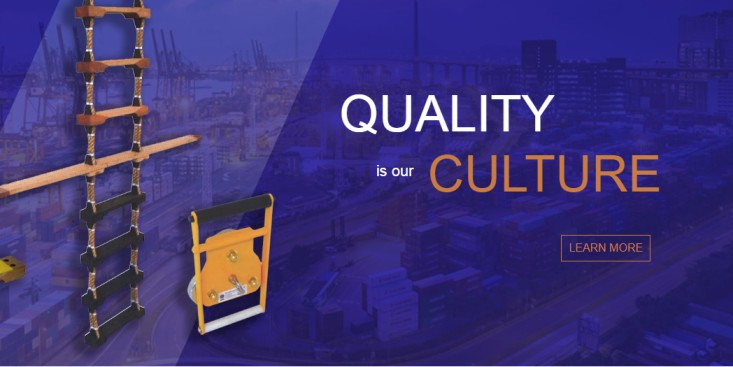In the vast expanse of the world’s oceans, where trade and commerce thrive, the role of maritime professionals is indispensable. Among the unsung heroes of the high seas are the seafarers who navigate through challenging waters to ensure the safe passage of vessels. One critical component of maritime safety is the pilot ladder, an essential tool that plays a pivotal role in the seamless transfer of pilots between ships and ports. In this blog post, we’ll explore the significance of pilot ladders and shed light on how SeaContractor, a prominent maritime company, prioritizes safety in its operations.
Understanding Pilot Ladders
Pilot ladders are specialized ladders designed for the safe embarkation and disembarkation of marine pilots. Pilots are highly trained individuals with expertise in navigating specific waterways. When a ship approaches a port or navigates through intricate channels, a pilot is often brought on board to guide the vessel safely. To facilitate this transfer, pilot ladders are rigged over the ship’s side to provide a secure means for the pilot to climb up or down.
Key Components of Pilot Ladders
-
Side Ropes: The ladder is typically constructed with strong side ropes that run parallel to the ladder steps. These side ropes are securely fastened to the ship’s structure and provide stability during the transfer process.
-
Wooden Steps: Traditionally, pilot ladders have wooden steps, offering a reliable and non-slip surface for pilots to climb. These steps are evenly spaced to ensure a comfortable ascent or descent.
-
Spreaders: To prevent the ladder from entangling with the ship’s structure, spreaders are used. These are horizontal bars that keep the side ropes apart, maintaining the ladder’s stability and preventing accidents.
-
Buoyant Properties: Pilot ladders are designed to be buoyant to ensure they remain afloat even if accidentally dropped into the water. This feature is crucial for both safety and ease of retrieval.
Importance of Pilot Ladders in Maritime Safety
-
Safe Pilot Transfer: The primary function of pilot ladders is to enable a safe transfer of pilots between ships and ports. This process is critical in ensuring that vessels receive expert guidance when navigating through challenging waters or approaching unfamiliar ports.
-
Compliance with Regulations: International Maritime Organization (IMO) regulations specify the standards for the design, construction, and usage of pilot ladders. Adhering to these regulations is crucial for maritime safety and compliance with international laws.
-
Reducing Risks and Accidents: Well-maintained and properly rigged pilot ladders significantly reduce the risks associated with pilot transfer. Accidents during this process can lead to injuries, damage to equipment, and even environmental disasters. SeaContractor places a strong emphasis on the regular inspection and maintenance of pilot ladders to mitigate these risks.
SeaContractor’s Commitment to Safety
As a leading player in the maritime industry, SeaContractor places safety at the forefront of its operations. The company recognizes that the effective use of pilot ladders is paramount in ensuring the well-being of its crew and the success of maritime missions.
-
Rigorous Training Programs: SeaContractor invests in comprehensive training programs for its crew members, ensuring that they are well-versed in the proper usage of pilot ladders. This includes training on ladder rigging, safety protocols, and emergency procedures.
-
Regular Inspections and Maintenance: The company follows a strict regimen of regular inspections and maintenance for all its equipment, including pilot ladders. This proactive approach not only ensures compliance with regulations but also enhances the overall safety of maritime operations.
-
Investment in Modern Technology: SeaContractor is at the forefront of adopting modern technologies aimed at improving safety standards. This includes the use of advanced materials in the construction of pilot ladders, enhanced design features, and the incorporation of smart sensors for real-time monitoring.
-
Collaboration with Regulatory Bodies: SeaContractor actively collaborates with maritime regulatory bodies and industry organizations to stay abreast of the latest developments in safety standards. This collaborative approach helps the company adapt its practices to evolving regulations and best practices.
Conclusion
In the vast and dynamic world of maritime operations, safety remains the cornerstone of success. Pilot ladders, often overlooked in their significance, play a crucial role in ensuring the safe transfer of pilots and, by extension, the safe navigation of vessels. SeaContractor’s commitment to safety, exemplified through rigorous training, regular inspections, technological advancements, and collaboration with regulatory bodies, underscores the company’s dedication to excellence in maritime operations. As we navigate the seas of progress, let us not forget the unsung hero – the pilot ladder – silently ensuring the safety of those who brave the open waters for the prosperity of global trade.


